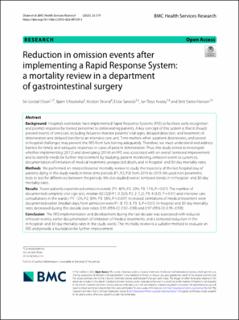| dc.contributor.author | Olsen, Siri Lerstøl | |
| dc.contributor.author | Nedrebø, Bjørn Steinar Olden | |
| dc.contributor.author | Strand, Kristian | |
| dc.contributor.author | Søreide, Eldar | |
| dc.contributor.author | Kvaløy, Jan Terje | |
| dc.contributor.author | Hansen, Britt Sætre | |
| dc.date.accessioned | 2023-06-23T13:11:56Z | |
| dc.date.available | 2023-06-23T13:11:56Z | |
| dc.date.created | 2023-03-15T14:08:15Z | |
| dc.date.issued | 2023-02 | |
| dc.identifier.citation | Olsen, S.L., Nedrebø, B.S., Strand, K., Søriede, E., Kvaløy, J.T. & Hansen, B.S. (2023) BMC Health Services Research, 23:179, 1-10. | en_US |
| dc.identifier.issn | 1472-6963 | |
| dc.identifier.uri | https://hdl.handle.net/11250/3072927 | |
| dc.description.abstract | Background
Hospitals worldwide have implemented Rapid Response Systems (RRS) to facilitate early recognition and prompt response by trained personnel to deteriorating patients. A key concept of this system is that it should prevent ‘events of omission’, including failure to monitor patients’ vital signs, delayed detection, and treatment of deterioration and delayed transfer to an intensive care unit. Time matters when a patient deteriorates, and several in-hospital challenges may prevent the RRS from functioning adequately. Therefore, we must understand and address barriers for timely and adequate responses in cases of patient deterioration. Thus, this study aimed to investigate whether implementing (2012) and developing (2016) an RRS was associated with an overall temporal improvement and to identify needs for further improvement by studying; patient monitoring, omission event occurrences, documentation of limitation of medical treatment, unexpected death, and in-hospital- and 30-day mortality rates.
Methods
We performed an interprofessional mortality review to study the trajectory of the last hospital stay of patients dying in the study wards in three time periods (P1, P2, P3) from 2010 to 2019. We used non-parametric tests to test for differences between the periods. We also studied overall temporal trends in in-hospital- and 30-day mortality rates.
Results
Fewer patients experienced omission events (P1: 40%, P2: 20%, P3: 11%, P = 0.01). The number of documented complete vital sign sets, median (Q1,Q3) P1: 0 (0,0), P2: 2 (1,2), P3: 4 (3,5), P = 0.01) and intensive care consultations in the wards ( P1: 12%, P2: 30%, P3: 33%, P = 0.007) increased. Limitations of medical treatment were documented earlier (median days from admission were P1: 8, P2: 8, P3: 3, P = 0.01). In-hospital and 30-day mortality rates decreased during this decade (rate ratios 0.95 (95% CI: 0.92–0.98) and 0.97 (95% CI: 0.95–0.99)).
Conclusion
The RRS implementation and development during the last decade was associated with reduced omission events, earlier documentation of limitation of medical treatments, and a temporal reduction in the in-hospital- and 30-day mortality rates in the study wards. The mortality review is a suitable method to evaluate an RRS and provide a foundation for further improvement. | en_US |
| dc.language.iso | eng | en_US |
| dc.publisher | BioMed Central | en_US |
| dc.rights | Navngivelse 4.0 Internasjonal | * |
| dc.rights.uri | http://creativecommons.org/licenses/by/4.0/deed.no | * |
| dc.subject | Rapid Response Systems | en_US |
| dc.subject | mortality rates | en_US |
| dc.subject | kirurgi | en_US |
| dc.title | Reduction in omission events after implementing a Rapid Response System: a mortality review in a department of gastrointestinal surgery | en_US |
| dc.type | Peer reviewed | en_US |
| dc.type | Journal article | en_US |
| dc.description.version | publishedVersion | en_US |
| dc.rights.holder | © 2023 The Author(s). | en_US |
| dc.subject.nsi | VDP::Medisinske Fag: 700::Klinisk medisinske fag: 750::Gasteroenterologisk kirurgi: 781 | en_US |
| dc.source.volume | 23 | en_US |
| dc.source.journal | BMC Health Services Research | en_US |
| dc.identifier.doi | 10.1186/s12913-023-09159-3 | |
| dc.identifier.cristin | 2134159 | |
| dc.source.articlenumber | 179 (2023) | en_US |
| cristin.ispublished | true | |
| cristin.fulltext | original | |
| cristin.qualitycode | 2 | |

